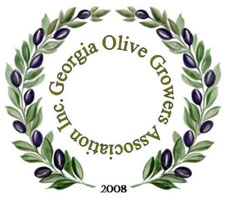Presentation by Dr. Gerard Krewer, UGA
Click here to download the presentation as a PDF
Click here to download the presentation as a PowerPoint
—————————————————-
The Past and Future of Olive Tree Production in Georgia
Presentation by Dr. Gerard Krewer, UGA
Click here to download the presentation as a PDF
Click here to download the presentation as a PowerPoint
—————————————————-
The Past and Future of Olive Tree Production in Georgia
By Mark Hanly and Shawn Davis

• In 1526, Lucas Vazquez de Ayllon’s colonists sent to the east coast from Hispaniola with 500 settlers and slaves.

• Always thought that they had traveled to SC

• Scholars now believe Lucas Vazquez de Ayllon’s colonists arrive in the continental US arrived off Sapelo Sound area off the coast of Georgia, a few miles from here.
• It is known they arrived on the Feast of Archangels, September 29, 1526, and that the colony was named San Miguel de Gualdape.
• A small town was built. Construction probably consisted of wattle-and-daub houses with a few timber and board buildings.
• After Ayllon died in the arms of one of the priests, the remaining 200 or so colonists set sail for Hispaniola. The colony lasted about six weeks to three months.
• Undoubtedly would have brought olives as the Spaniards always did.

• Franciscan Friars
Fray Pedro de Corpa, came to Spanish Florida in 1587 and was sent to the Guale village of Tolomato, near modern-day Darien.
• As the Franciscans marched north establishing missions in California, they also planted olive groves.
• There is no doubt that they did the same thing here in Georgia.
• Olive Pits at excavations in Georgia.
• The California Mission Olive is a variety unique to the United States. Although its origin was believed to be Spanish, tests at the University of Spain at Cardoba were unable to link it to any of the 700 varieties documented there. The roots of the California Mission Olive are in the orchards of the Jesuit and Franciscan missions founded several centuries ago.
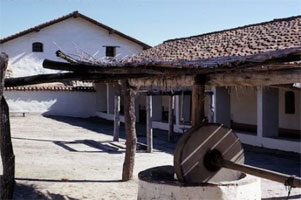
• Olive press at la Purisima Mission California.

• British settlers arriving in Georgia in 1736 found olives and orange trees growing in the area of the Saint Simons light house.
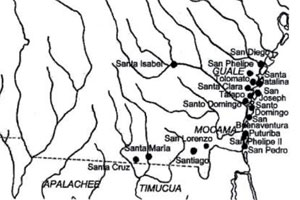
• Sour orange and olives found at sites of old missions.
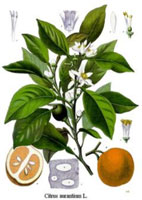
• Spaniards introduced the sour orange (C. aurantium) to East coast of US. It was quickly adopted by the early settlers and local Indians. Today, the sour orange is found growing wild even in southern Georgia (Morton, J. 1987. Sour Orange. p. 130–133. In: Fruits of warm climates. Julia F. Morton, Miami, FL)
• Nathaniel Green, the American patriot, and then owner of Cumberland Island off the coast of Georgia, found some olive trees growing from the time of the Spanish missions.(Jeffersonian Olive)
• Enlisted the aid of Thomas Jefferson to sell the island’s oak to the French and replant with olives from France.
• Jefferson was minister to Europe 1789 wastaken by “Olives and Olive oil”.
• Arranged for the shipment of 500 trees to Georgia and South Carolina.
The trees arrived at Charleston in 1791 although some reports state that the first olive trees under British rule were planted there as far back as 1670’s
• In Georgia, James Hamilton Couper of St Simons Island imported 200 trees in 1825 and within 16 years had attained the diameter of 9 inches.

• Couper propagated the plant and produced both oil and picked olives.
• Thomas Spalding did the same, getting olives from Leguorno in Italy in 1827
• Olives from Hamilton Coupers plantation
were still in production in 1895
• Encyclopedia Britannia of 1881 states when dealing with Georgia ” In the flat low lands the orange, lemon, banana and OLIVE come to perfection…”
• I have seen a report of as much as 3000 barrels of pickled olives shipped from Brunswick in mid 1800’s.
• After having grown olives in Appling county for three years — I know they grown and there is a sustained history over several hundred years of them being grown.
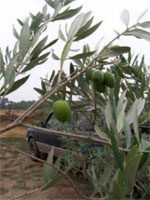
• So what happened?

• Civil war
-Production in those days very labor intense.
• Early years so volume and efficiency of production could not meet the scale of more established areas of production.
• Cotton seed oil.
• Olives can be grown here
• I have had trees in for 3 years
• We can meet the needs of a niche market of high end specialty product.
• Possibility that we can meet the prices of the bulk produces of the Mediterranean.
• Opportunity of developing a vibrant olive industry here in coastal Georgia.
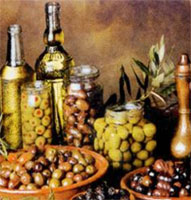
•US market growth:
-U.S. olive oil sales are on track to hit $1.3 -1.5 billion by 2010, according to recent market research.
-Sales are expected to hit or even exceed nearly $1 billion
• While olive oil is well known for its flavor and health benefits, the leaf has been used medicinally for thousands of years either as extract or tea.
• Natural olive leaf and olive leaf extracts (OLE), are now marketed as anti-aging, immunostimulators, and even antibiotics.
• Clinical evidence has proven the blood pressure lowering effects of carefully extracted Olive Leaf Extracts.
• Bioassays support its antibacterial, antifungal and anti-inflammatory effects at a laboratory level.
• A liquid extract made directly from fresh olive leaves recently gained international attention when it was shown to have an antioxidant power almost double green tea extract and 400% higher than Vitamin C.




• Healthy Properties and Organoleptic Abilities
• Olive oil contains monounsaturated fats which can lower your risk of heart disease by reducing the total and low-density lipoprotein (LDL, or “bad”) cholesterol levels in your blood.
•Contain highest levels of polyphenols, powerful antioxidants along with Premier Flavors
• Hypertension. Int J Food Sci Nutr. 2005 Dec;56(8):613-20 ; Phytother Res. 2008 Sep;22(9):1239-42.; Arzneimittelforschung 2002;52 (11):797-802.
• Infection. Molecules. 2007 May 26;12(5):1153-62.
• Diabetes. Phytother Res. 2008 Oct 9.
• Cancer. Eur J Cancer Prev. 2004 Aug;13(4):319-26.
• Atherosclerosis. 1: Curr Atheroscler Rep. 2001 Jan;3(1):64-7.

• A new model of olive cultivation, “High Density System” with new improved dwarfing clones
• Spacing 12 foot rows – 5 to 6 ft apart
• Faster Production, Quicker Return
• Higher Yields — 5 to 7 tons per acre
• Mechanical Harvesting – less labor intensive
• Equipment Used — similarities with Blueberry industry
• United States imports 76 million gallons of olive oil
• US consumption growing at 8 ½ % annually
• Domestic production does not reach one percent of what is imported
• Asian countries like Japan are doubling their imports
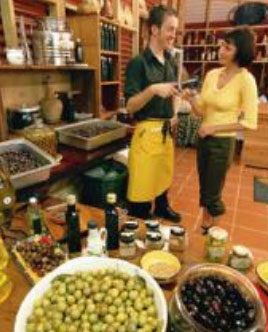



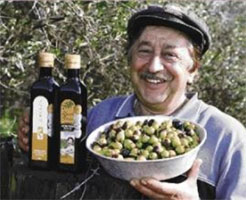
— Leaf teas/extracts
• Soaps
• Cosmetics
• Tourism
